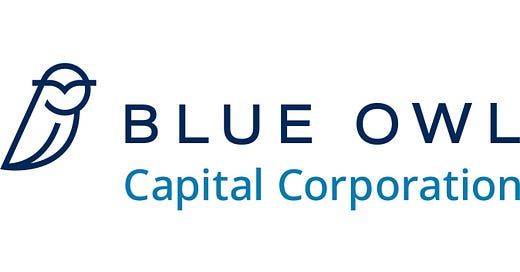Executive Summary:
Despite mounting signals of stress in private credit markets, valuations today reflect one of two increasingly improbable scenarios: either a perfect "Goldilocks" combination of a soft landing and return to (near) zero rates, or an ability to indefinitely "amend and pretend" troubled credits. This is particularly evident in Business Development Companies (BDCs), where retail and income-focused investors continue to accept portfolio marks at face value despite clear signs of deterioration (IMF, 2024). My thesis is that the probability of either scenario persisting is materially lower than current market pricing suggests, creating opportunities to short highly levered BDCs with concentrated unsecured portfolios and rising payment-in-kind (PIK) interest.
Roots of the Situation:
The roots of today's vulnerability trace back to the post-GFC era, when the central bank cut rates and implemented aggressive quantitative easing measures to stabilize the economy and financial markets. The resulting zero-rate, highly liquid environment proved fertile ground for Private Equity investors. Cheap credit accelerated PE returns, and yield-chasing investors reallocated capital to the asset class as returns grew (Caia, 2023). This increased capital supply fueled multiple expansion as more money chased the same deals, creating a self-reinforcing cycle (HBS, 2024). This cycle continued until 2022, when the Fed hiked rates 11 times for a total increase of 550bps (The Street, 2024). Suddenly, PE sponsors who had borrowed at peak valuations found themselves squeezed by rising payments (Institutional Investor, 2024). As traditional lenders retreated, Private Credit funds stepped in to buy hung loans, under the assumption that they could leverage their long time horizons and low distribution requirements to harvest yield while waiting for rates to normalize (Deutsche Bank, 2024).
The Rise of Cov-Lite and Loose Lending
High yields and low PE returns accelerated significant capital inflows into Private Credit, ballooning the industry to over $1.5T in AUM (Blackrock, 2023). However, this additional capital was left chasing fewer deals as M&A markets dried up. Credit spreads tightened, and lenders increasingly relied on covenant-lite loans as competition intensified (S&P Global, 2024). The constant threat of creditor-on-creditor violence kept negotiating leverage with sponsors, who demanded shockingly low spreads for increasingly non-productive uses of capital (NBER, 2024). For example, Ellucian, a Blackstone and Vista Equity Partners backed higher education company, recently raised a CCC-rated second lien loan at just +475/99.5 to fund a dividend payout (S&P Global, 2024). These risky, low-covenant, low-spread loans have left minimal room for error for creditors.
Signs of Structural Weakness
Today, 40% of companies have Fixed Charge Coverage Ratios (FCCRs) less than one, meaning they're not producing enough cash flow to cover interest expense (Bloomberg, 2024). This trend is even more extreme among B3 rated companies, where 62% have coverage ratios below 1 (Gresham Partners, 2024). In fact, the average interest coverage ratio for Private Credit borrowers has declined by 55% since 2021 (Houlihan Lokey, 2024).
As a result of these low coverage ratios, the percentage of BDC income being paid as PIK rather than cash has doubled in the last 6 years, from 4 to 8% (Fitch Ratings, 2024), indicating borrowers are increasingly relying on PIK to avoid defaults. This trend is particularly extreme amongst certain BDCs, where PIK rates have ballooned to as high as 24%.
Even with the rise in PIK use, nearly 10% of actively rated private credit issuers are operating under covenant waivers or amendments, suggesting many borrowers are effectively bankrupt but have leveraged their negotiating power to keep lenders at the table (Gresham Partners, 2024).
Monetizing the Thesis
While systemic defaults across private credit markets are unlikely, and well-capitalized lenders with diversified, senior-secured portfolios should be able to weather potential stress, highly levered BDCs with concentrated, unsecured exposure offer compelling short opportunities. Several potential short targets are listed below:
Blue Owl Capital Corporation (OBDC): OBDC is a compelling short position. The fund has a levered portfolio with a debt-to-equity ratio of 1.3x as of June 2024. The stock trades at a premium to NAV, suggesting significant market complacency and implying that the market has priced a 0% default rate despite a 25% rise in the use of PIK and 19% of loans being unsecured (Blue Owl Capital Corp).
New Mountain Finance Corporation (NMFC): NMFC offers another compelling short. The fund has a levered portfolio with a debt-to-equity ratio of 1.3x as of June 2024. Based on the company’s slight discount vs NAV, the market has only priced a 1% default rate despite a 36% rise in PIK as a % of Net Income and 25% of loans being unsecured (New Mountain Finance Corp).
Great Elm Capital Corporation (GECC): GECC offers another compelling short, despite significant price adjustment since 2022. GECC has a levered portfolio with a debt-to-equity ratio of 1.4x as of June 2024. Based on the company’s discount vs NAV, the market has priced roughly a 3% default rate despite a 15% rise in PIK as a % of Net Income and 40% of loans being unsecured (Great Elm Capital Corp).
Thesis Catalysts
Three potential catalysts could force recognition of underlying portfolio stress in the next five years. Most directly, I expect to see rising default rates as the "amend and pretend" game becomes increasingly difficult to maintain in a higher-for-longer rate environment (McKinsey, 2024). Even absent defaults, mounting PIK balances will eventually force dividend cuts as cash income declines, triggering selling pressure from yield-focused investors who constitute a large portion of the BDC shareholder base. Finally, any resurgence in inflation - perhaps triggered by escalating tariff wars between major economies - could force renewed rate hikes, pushing already-stressed borrowers toward default and further reducing cash available for distributions (Fitch, 2024).



